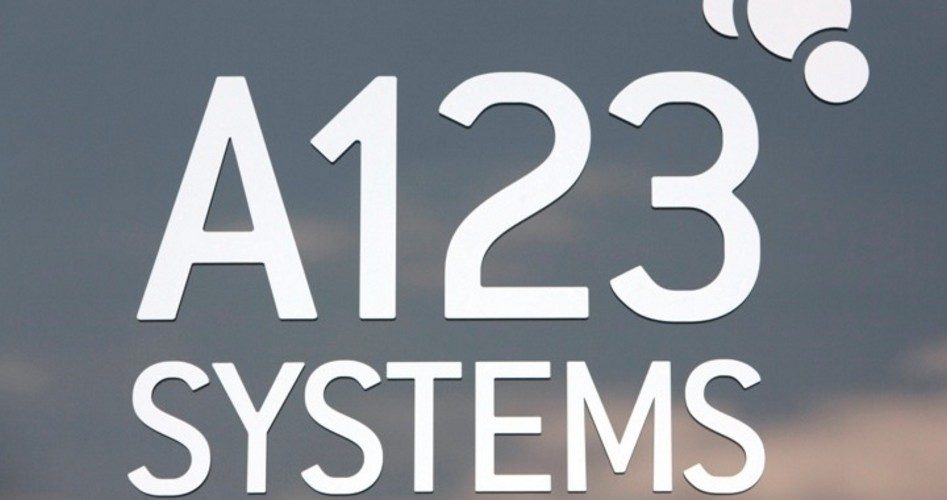
A financially strapped Massachusetts-based firm that manufactures batteries for electric cars, which reaped some $240 million in federal stimulus money, is being rescued by a Chinese manufacturing behemoth, owned by renowned Chinese billionaire Lu Guanqiu. A123 Systems, which was awarded a $241.1-million grant from the Obama administration and more than $125 million in state of Michigan tax credits, was once touted for its purported commitment to create thousands of jobs, while helping curb the use of conventional gas-powered vehicles and transitioning to a more “green” energy environment.
But according to a company press release, the lithium battery maker is handing its operational reins over to Wanxiang Group Corporation, China’s largest automotive components manufacturer and one of the country’s largest non-government-owned firms. Under the agreement, Wanxiang plans to invest as much as $465 million in A123, including an initial credit extension of $25 million, giving the Chinese manufacturer up to 80 percent of the company.
“We consider today’s announcement to be a strong validation of A123’s technology and the company’s ability to compete in high-growth markets,” asserted David Vieau, CEO of A123, putting a positive spin on the firm’s woeful financial condition. “We believe that the significant commitment of capital from Wanxiang would help strengthen A123’s financial position, and by leveraging Wanxiang’s global capabilities, we expect to see increased demand for our products. Further, Wanxiang has demonstrated its commitment to partnering with and investing in U.S. companies, so we also believe that we will continue to expand on our strong manufacturing and systems engineering capabilities in Michigan and Massachusetts.”
Since 2009, around the time when A123 received more than $240 million from the Obama administration, it has lost a reported $857 million, as well as laying off employees and recalling some of its products. Meanwhile, the firm’s stock price has plummeted from $4.44 about a year ago to a mere 26 cents this week.
Critics have been quick to excoriate the president’s persistent campaign to bolster green energy firms that have later fallen into financial turmoil. “They were wrong,” said Jarrett Skorup, a research associate with the Mackinac Center for Public Policy. “The problem is that policymakers decided to be in the business of picking economic winners and losers and unfortunately they’ve picked the losers far too often.”
“It’s money that we’ll never get back,” Skorup added, highlighting the hundreds of millions of dollars A123 secured from Obama’s controversial stimulus law. “It was grant money so there were not a lot of strings attached to it.”
The company’s financial crisis has been ignited by a number of factors, including diminished demand for batteries that charge electric vehicles, a condition largely out of A123’s control. “It failed because there’s not enough demand and also because there are companies outside of the U.S. — some in China — where they’re able to produce the equipment for cheaper,” Skorup told FoxNew.com. “Representatives should not be in this business of trying to determine what the next new thing is in terms of technology. The free market does it much better.”
One of the more controversial aspects of the A123 buyout is the question of whether Wanxiang may move the manufacturer to China, resulting in the export of hundreds of American jobs. “The issue of having the Chinese come in after the United States has supported the company with loans is a challenge for them,” Bruce Belzowski, an analyst with the University of Michigan Transportation Research Institute, said of the buyout. “Do they end up moving the plant to China? As owners they would have that right to do that.”
Pike Research analyst John Gartner says exporting A123’s operations to China is very probable, considering the cost advantages that may be associated with the move. “Because of the weight of the batteries, it’s much more cost effective to manufacture where they’re going to be used in the vehicles,” Gartner said in an interview with the Detroit Free Press.
Similar to actions he took with numerous other failed green energy companies, President Obama once hailed A123 as the poster child of “what’s possible in a clean energy economy,” claiming that the firm’s potential for success could add jobs to the stale U.S. labor market. “Truth be told, A123 was looking to build that factory in Asia,” Obama said in April 2010, indicating that the stimulus money would keep A123’s manufacturing operations in the United States. “But because it received that grant, it chose the state of Michigan for its largest and most innovative plant yet.”
“And that plant will be one of 30 new plants to go fully operational over the next six years, manufacturing electric vehicle batteries and components right here in the United States of America,” the president added. “So this is what’s possible in a clean energy economy.”
A123’s financial woes — and consequently, its buyout from a Chinese-owned firm — have been added to the Obama administration’s growing record of green-investment boondoggles. And similar to that of Solyndra, a solar-panel maker that went belly up after garnering $535 million in federal loans, A123 is another example of hundreds of millions of taxpayer dollars funneled into the hands of an uprooted industry that has yet to prove itself.
Photo of A123 Systems logo: AP Images



